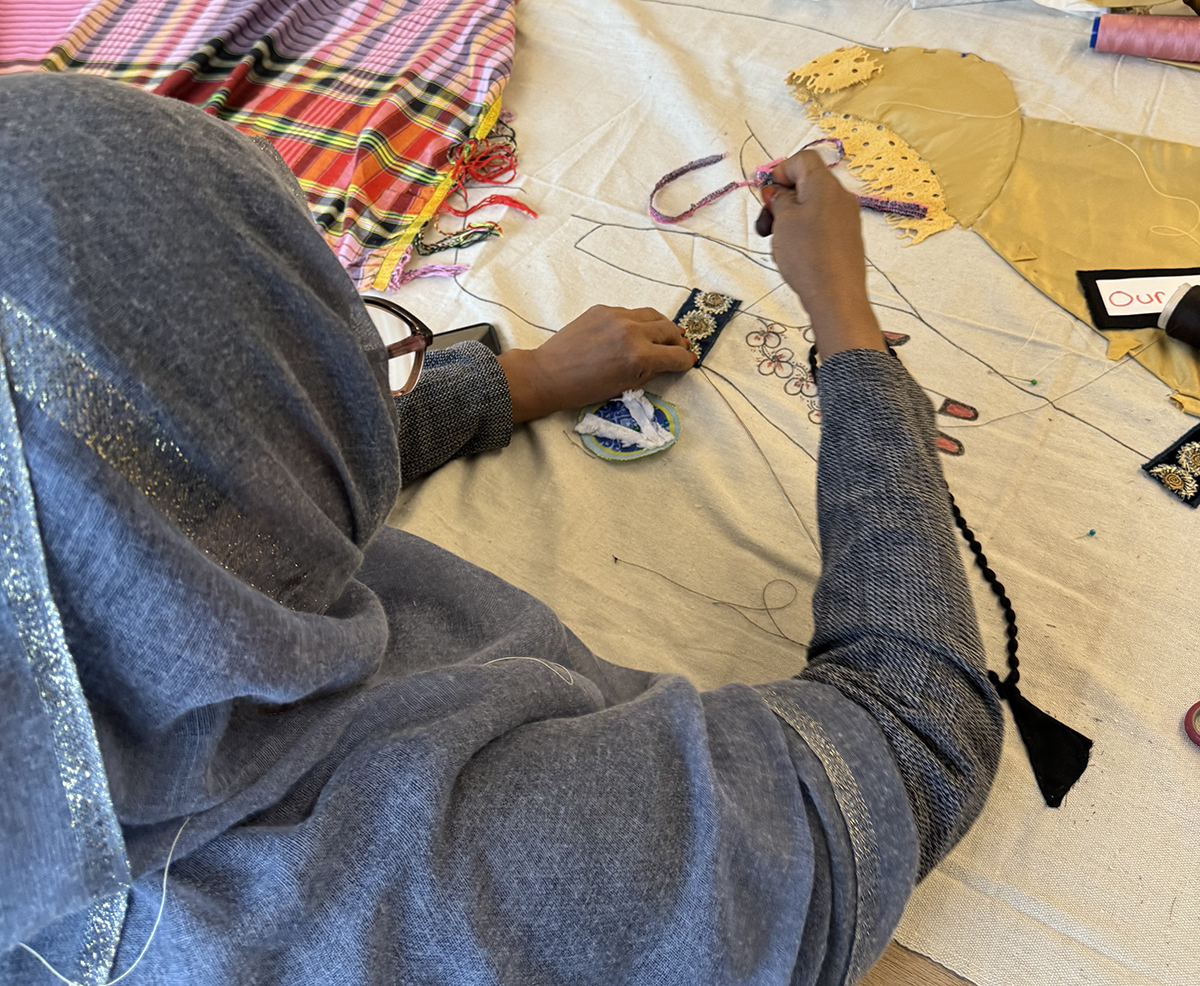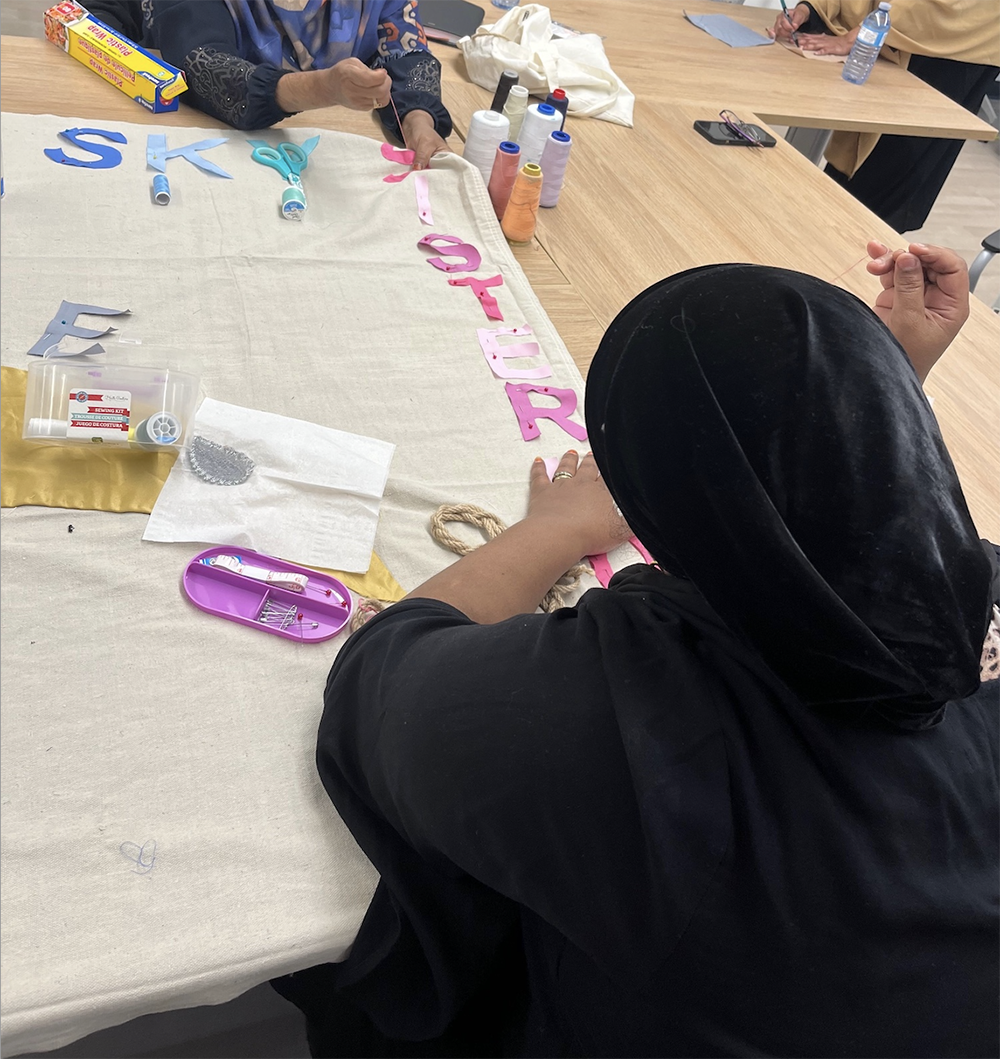“Reclaiming narratives from the shadows of gun violence” — how a group of women engaged in community-building, empowerment and advocacy through art
Categories: Faculty, Stephanie Begun, Students
This past Fall, a group of Somali-Canadian women in Toronto’s north-west end came together in an effort to heal through art, but the art-based exercise didn’t just provide the women with a way to express their grief — it also strengthened their solidarity and produced a tool to raise awareness about the challenges they’ve faced and their perseverance and strength to overcome them.
The women are participants in a program called Mending a Crack in the Sky (MCIS), which was established in partnership with Midaynta Community Services to support families impacted by gun violence as they grieve and work together to promote awareness and advocate for change in their community. The art — a body mapping project — was facilitated by Stephanie Begun, an associate professor at the Factor-Inwentash Faculty of social work, and research assistants Vilmara Lucas and Carolyn O’Connor in collaboration with the participants.
“I had long admired the advocacy and outreach efforts led by MCIS. For quite some time, I had also wanted to explore body-map storytelling, an arts-based research method, in partnership with community,” says Begun, whose research has used arts-based research with community in the past. (In 2021, for example, she partnered with Second City to explore how improv could cultivate confidence in marginalized youth.)
Body mapping is a process that typically involves sketching, painting, or using other arts-based materials to create annotated body maps as visual representations of people’s life journeys. The method has been adapted in a wide array of ways, but most often serves to garner dialogue and share stories. The process of creating and sharing these maps is often experienced by participants as healing, solidarity-building, and can lead to awareness-raising.

Stephanie Begun, Vilmara Lucas, and Carolyn O’Connor
In partnership with Midaynta Community services staff, who provided co-facilitation and translation, Begun, Lucas and O’Connor led a five-part workshop to introduce the body-map storytelling as a concept, letting the women know that they could ultimately approach this activity in whatever way felt most comfortable and interesting to them.
“After poignant conversations and dialogues about their lived experiences of losing family and community members to gun violence, the group decided that they did not want to make individual body-maps, but rather, one collective body-map that could serve as a symbol for the group as a whole, but with individualized messages and artwork from group members woven throughout the collective body-map,” says Begun.
The group also decided that they wanted to create something that would make a lasting impression and impact, she says. Rather than sketching a body-map on paper, as is often the approach, they decided to create their map on a large piece of heavy canvas, with all personalized artifacts embroidered and carefully sewn into the canvas.
The group’s intent is to use this body-map creation as an art installation, an awareness-raising visual, and even a protest banner to call for an end to gun violence.
“As women created art together, they found a sense of belonging, healing, and community. I was so honored to be a part of such special moments,” says Lucas, who, along with O’Connor is also a PhD student at FIFSW. “One particular moment that struck a chord with me was when a mother bravely declared, ‘I don’t cry about it anymore, I talk about it.’ Her words encapsulated the transformative power of the group in fostering healing and resilience. It was a reminder of the strength that lies in community, and the importance of sharing our experiences and emotions with others.”
O’Connor shared similar sentiments. “It was such a privilege to be a part of this workshop and this incredible group of women, who have worked together to develop a space for solidarity, connection, and advocacy,” she says. “Being able to witness the evolution of the art they co-created was a moving experience. The final product was both a tool for activism and a symbol of peace.”
Participant voices
 “Following our project, we asked participants about their experiences in these workshops, for their insights on body-map storytelling as a method for bringing people together, and what they hoped their collective creativity would inspire beyond the workshops,” says Begun.
“Following our project, we asked participants about their experiences in these workshops, for their insights on body-map storytelling as a method for bringing people together, and what they hoped their collective creativity would inspire beyond the workshops,” says Begun.
Here are some of these (blinded) quotes from participants:
“Body mapping has allowed a group of Somali mothers to all be in the same space, empowering each other to tell their stories in a way that exuberates compassion and promotes healing.”
“Through body mapping, MCIS mothers have been given the privilege to create a banner that portraits their pain, however it also inspires sisterhood and togetherness. The banner captures memories of laughter and tears with the raw anguish of loss, creating an embroidery of courage and hope.”
“I dedicate my body mapping experience to my son. Your memory will be engraved into this beacon of hope! Your legacy and honour will leave a symbolic remembrance, transforming pain into courage. Love transcends the violence that took him away.”
“The body mapping project has provided me the platform to feel connected to other mothers in my community. It allowed me to have the space to dive into unresolved and untapped emotions that I was holding inside my body. As the other mothers shared their lived experience, it provided me the strength to unpack all my hidden emotions.”
“I am proud to have created a physical banner that the MCIS mothers had autonomy over! It is a representation of solitude and sisterhood, overcoming grief and pain collectively whilst manifesting justice for all the victims inflicted by harm done by the Justice system. We find solace in the shared experiences of loss, stitching together fragments of memories with threads of resilience, creating a patchwork of healing.”
“Through body mapping, mothers reclaim their narratives from the shadows of gun violence, each line a finger-print and declaration of strength, each color a beacon of hope in the face of tragedy.”
“Body mapping becomes a sanctuary for mothers grieving the irreplaceable loss of their loved ones to gun violence, where pain finds expression in the language of art, and healing begins with each stitch of thread.”
“When I first started the Body-mapping initiative, I was a bit hesitant. As I got the groove of the project, it allowed me to embrace my body and self-healing. The mural symbolized relief. It provided me the reassurance that I can have a physical display to showcase how I overcame adversity. I hope this piece of art work can be shared in City Hall and Queens Park, I want to showcase the work MCIS does to contribute to community healing projects!”
Learn more about Mending a Crack in the Sky